-
Engine6.2L Supercharged V8
-
Power650 HP / 650 LB-FT
-
Transmission6-Sp. Manual
-
DrivetrainRWD
-
Engine PlacementFront
-
Curb Weight3,820 LBS
-
Seating2+2
-
Base Price$70,990
The 1LE badge wasn't meant to conjure up an image of a track-dominating pony car, originally. It was just an ordering shorthand, a Regular Production Option, a box to check so the line worker knows what to bolt onto the next car. Some RPO codes have acquired a mythos, becoming marketing terms unto themselves. ZR1, Z71, Z28. But the 1LE, despite sounding like a base trim level on a Cruze, is something special.
Racing plays a large part in the 1LE's beginnings. In the mid-1980s, Camaros were running in a Canadian showroom stock class called Player's Challenge. The hardware GM was screwing on the cars from the factory wouldn't cut it, so the engineers devised a brake and handing package and then picked an RPO code to sell it under. GM wasn't marketing the car, probably so as not to draw competitor's attention to the enhancements, but by the fifth generation GM realized the 1LE resonated with the Camaro crowd, and the Zeta 1LE (a handling package on SS models full of trickle-down ZL1 bits) helped bring the RPO code out of obscurity.
Don't forget that the 1LE badge is tacked onto the back of another legend, ZL1. That code originally snuck massively underrated, race-developed big-blocks into a few unassuming '69 Camaros. Heady stuff. The new ZL1, now in its second generation as a supercharged super-Camaro, is a combination of show and go – and it actually handles, too. (If the ZL1 1LE is too much, you can also spec 2017+ V6 and V8s with a track package sharing the 1LE code.)
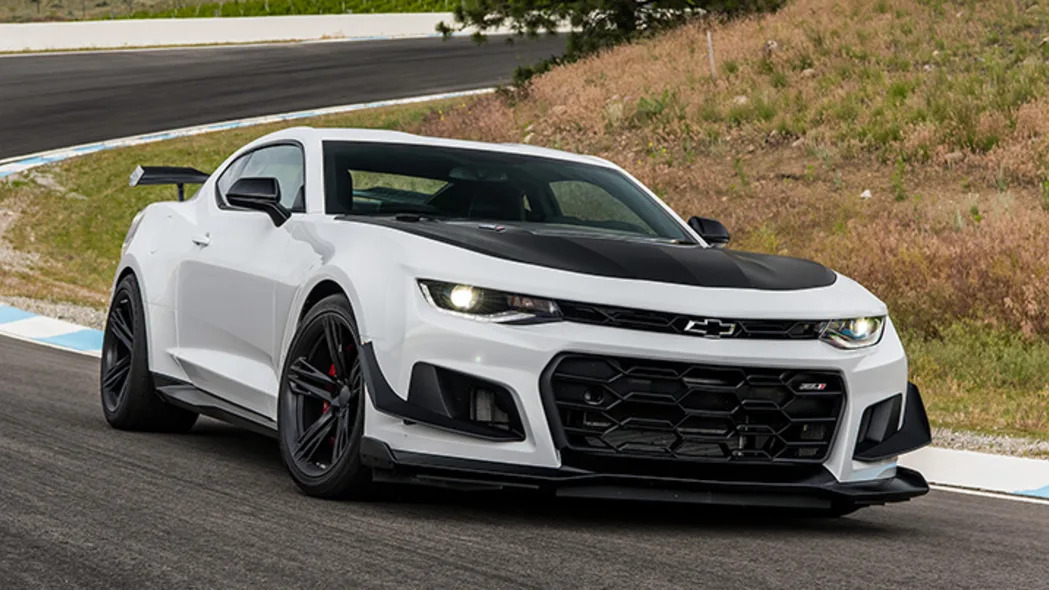
Much of what Chevrolet changed is in order to leverage some truly impressive rubber. The last-generation Z/28, a good reference point for the new 1LE, used some very sticky Pirelli Trofeo Rs, barely street legal and grippy like hot tar. Chevy switched to Goodyear for the 1LE's tires, steamrollers at P305/30ZR19 and P32530ZR19. The Eagle F1 Supercar 3Rs, thanks to an exotic compound and more width in the rear (the Z/28 wore 305/30s all around), trounce the Trofeo Rs. These are DOT-legal tires, although on the hairy fringe of sanity, and a lot of the reason the 1LE can corner at 1.10 G.
That's right. One-point-one. That's a tenth of a G increase over the Z/28, and would best a 991 GT3 RS. Who said pony cars can't handle?
A lot of that is due to the control provided by the Multimatic DSSV (Dynamic Suspension, Spool Valve) shocks and the way they're mounted to the Camaro. They're similar in basic operation to what the Zeta Z/28 wore but recalibrated for this car's weight and the tires. The rears are essentially identical to Z/28 units, but also recalibrated. Up front, the struts get aluminum bodies instead of steel, topped by a two-position camber plate (-1.5 for the street, -3.0 for the track). The rubber isolator was ditched, so these are hard-mounted to the shock towers – more rigidity and precise control, and it saved a bit of weight. The spring perch is adjustable so you can change the ride height up or down 10 mm. There's more adjustability in the rear stabilizer bar, with a neutral position as well as a +10 percent and -10 percent stiffness position. The rear cradle is also hard-mounted, with aluminum pucks instead of rubber.
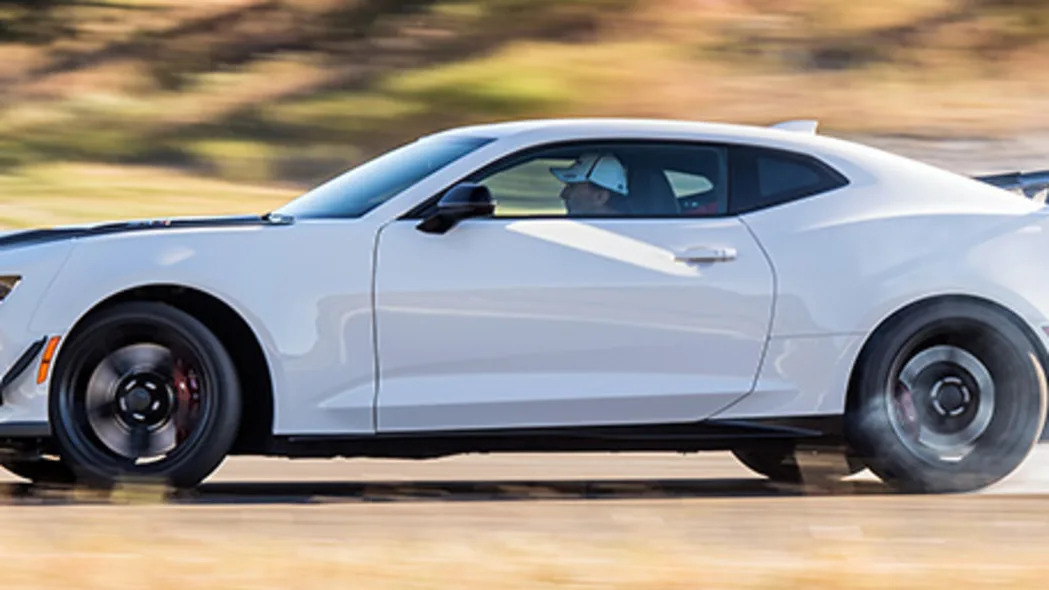
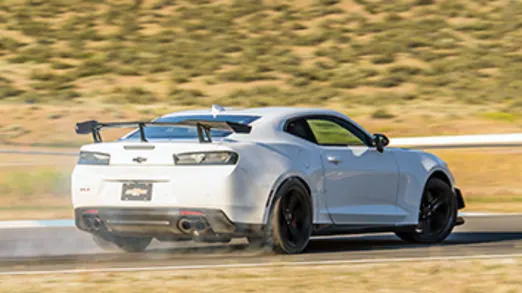
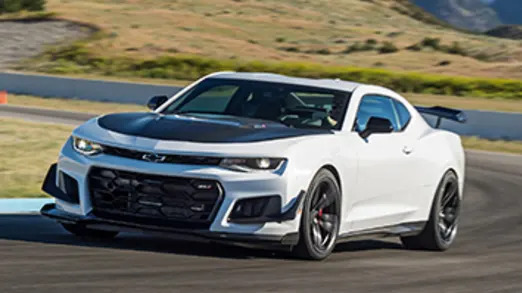
Read through all that and you'd expect a joint-rattling ride. It's certainly stiff, but the person the 1LE will appeal to won't mind. Everyone else can save some dough and just grab a regular ZL1 with its more compliant rubber mounts and Magnetic Ride suspension.
As radical as the handling hardware is, the powertrain is largely the same. The engine output – 650 hp and 650 lb-ft of torque – and calibration are identical. The Tremec 6060 six-speed manual, the go-to 'box for American performance cars, has a shorter fifth and sixth. The eLSD has a unique calibration, but the final ratio is the same. That's pretty much it on the powertrain side.
Chevy did jettison some weight in order to offset the goodies it bolted on. And by some, I mean a lot. The aluminum bodies on the front shocks, for example, saved 18 pounds of unsprung mass alone. In total, the DSSV shocks are 23 pounds lighter than the Magnetic Ride system found on the regular ZL1. The rear seat is thinner, made of stiffer foam, and won't fold down – that's good for some mass reduction. A thinner rear window saves 4-5 pounds. It's a wash compared to the no-A/C Z/28, which of course was on a larger and heavier platform to begin with, and about 75 lbs lighter than the current manual-transmission ZL1.
If the equipment the 1LE had underneath it was serious, so was the place we'd be finding out how it all worked together. Area 27 is a brand-new Canadian road course, just north of the American border in British Columbia. It's long – 3.1 miles – and technical enough to load up the 1LE and toss it around a bit. Some of the nastier turns would chuck an ill-handling, big-power car off with hardly a shrug. It's a private track club sort of deal, and there's a lot of hoopla about Jacques Villeneuve's involvement. And considering the Camaro's racing history north of the border, in a series obscure to Americans (like the Player's Challenge series that spawned the ur-1LE itself) but well-remembered by Canadian motorsports nuts, it's a good place to party.
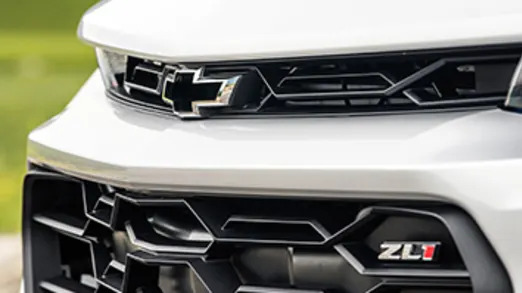
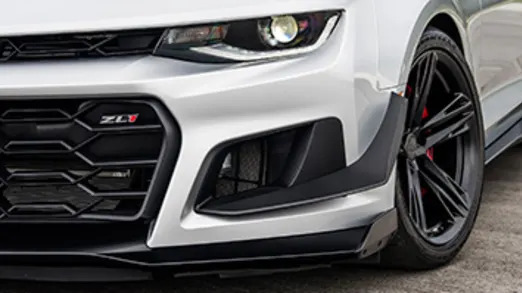
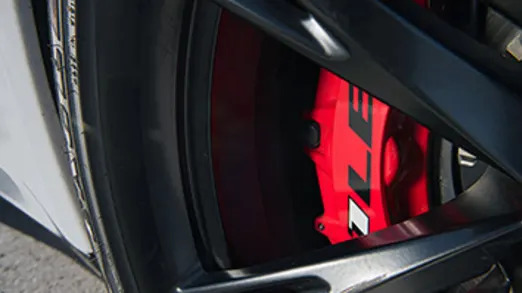
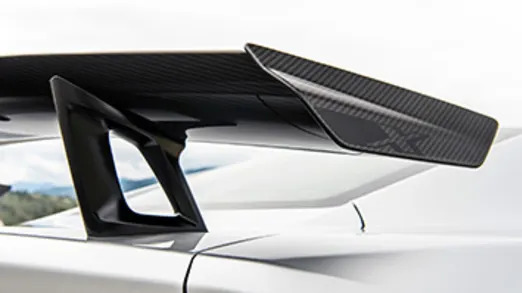
And the ZL1 1LE does like to party, and it's dressed for the occasion. All the aero bits are functional; the massive double-sickle rear wing alone is good for 300 pounds of downforce at 150 mph. Those front dive planes are good for more than dealer revenue when they're ripped off in the car wash – they also improve downforce, and in a roundabout way help to reduce weight. You see, to make 'em fit GM had to remove the separate daytime running lights, which saved 7 pounds. The DRL units are required in Europe, but Chevy isn't going to sell the 1LE outside of North America, so it doesn't matter.
Whether the aero adds any beauty to the Camaro – no one could accuse it of being uncluttered, although it's certainly purposeful – is for you to decide, but what is undeniable is that the 1LE has the handling to back up 650 horsepower. And the brakes – iron, but at 15.3 front and 14.4 rear, plenty for the Brembo calipers to grab – are up to the task of hauling down a 3,820-pound car in preparation for chucking it into a turn. Driven hard, it's noticeably more aggressive than the old Z/28, which had a sort of gracefulness you wouldn't expect in a Camaro. The 1LE is brutish without being brutal, and to get the most out of it you have to work a bit to overcome front end scrub. Expertly manhandled, the 1LE does incredible things.
Ergonomics make the manhandling all the easier. The Tremec six-speed is perfectly geared for a track like this, and rowing it is a joy. This is a variant of a gearbox used in nearly every high-horsepower American car that has offered a manual in the past decade or so, descended from the mighty T-56. The 1LE has the characteristic positive engagement, paired with a pedal box that's as familiar as your nearly worn-out driving sneakers. It's like the anti-Viper, a car that used the same gearbox but required contortion for every motion. The same goes for the steering. Who would've thought that GM would succeed where legendary companies like BMW have struggled mightily? Just like the C7 'Vette, the 1LE's variable-ratio electrically-assisted steering is precise and predictable, with an appropriate heft and plenty of road feel.
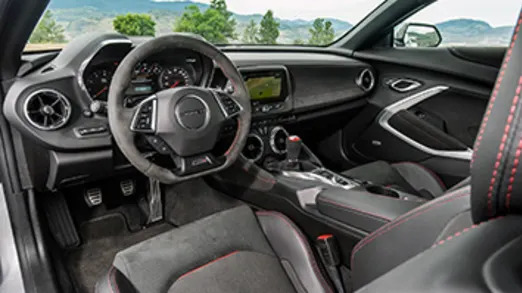

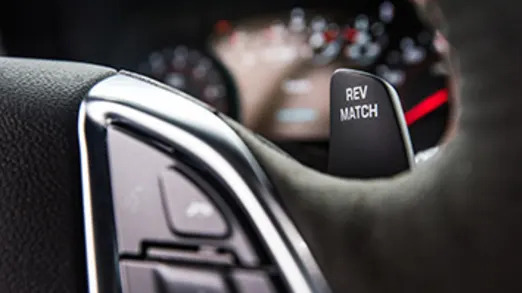
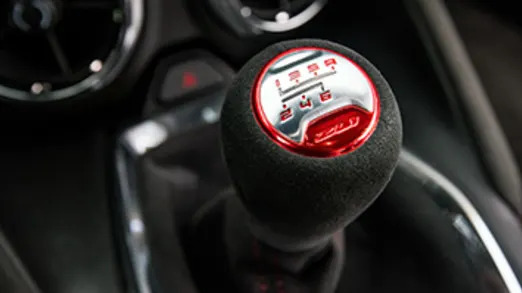
Maybe it's the longer wheelbase or the rubber, but the 1LE isn't a handful despite the LT4 trying to reverse the orbit of the Earth at every corner exit. Actually, a lot of that is the combination of the eLSD and advanced traction management software, which left in Track mode is less of a nanny and more of a safety net. As it sat, with the suspension and stabilizer bars set to full track and the software keeping a watchful eye, the 1LE exhibited mild understeer and a bit of throttle intervention on overenthusiastic exits. More than enough bandwidth to learn lines and set initial times. And of course, it can be turned off when the safety net isn't needed.
At that point, it's the tires that become the star. Area 27 is more than three miles long, and with a heavy car that likes to push a bit, heat would be a problem in lesser tires. The Goodyears, somehow, managed to take the abuse without developing any nasty habits, staying predictable and sticky soon after track out and until the end of our 2.5-lap stints. How the tire behaves 10 laps in I couldn't say, and perhaps there's a gradual falloff in adhesion, but considering the wide and forgiving breakaway characteristics I've got no complaints.
As Bill Wise, whose title of ride and handling development engineer doesn't really do his role justice, told us, "[It] won't snap on you. You can correct a slide with a bit of steering angle, but you don't have to back out of the throttle ... It's a lot of car, but we wanted to make it approachable. We really focused on make the car drivable for every customer." Wise is the guy who set the Nürburgring lap time of 7:16.04, so I wanted to believe him. But this is a 650-horsepower Camaro, and he's a shoe, so maybe the definition of "drivable" would prove to be a bit fuzzy. As I'd find out soon enough, he was completely correct.
Below, you can see pro driver Lawson Aschenbach put Wise's words to motion.
You'd think jacking up the loads this much on a streetable tire would mean they'd bite you hard if you overcook 'em, but the 1LE's Goodyears give you a long, gentle reminder that things are about to go sideways. And remember, this is DOT-legal rubber.
Coming off the track, I had a realization that a word I hate was the perfect one to describe the 1LE's relationship with Area 27: "synergy." Take a minute to grab the eye bleach; I'll wait. All good? The 1LE isn't the low-key track assassin that, say, the GT3 is. It's dramatic. Motions are big, the sound is intense, the grip is tremendous. Picture a vintage Trans-Am car that isn't trying to kill you, that'll actually idle. It's entertaining, not just because the limits are huge, but because the danger zone as you work up to the limit is as fat as those Goodyears. If you loop the thing, well, it's not like you weren't warned.
There might be more enjoyable cars out there for $70,990, but of that subset not too many seem to snub physics and prejudices quite like the 1LE. Compared straight-across to the regular ZL1, the $7,500 premium seems like a deal. It's a lot of money, but it'd take some serious aftermarket development to get the kind of handling out of the thing. Look, GM and its cohorts at Multimatic and Goodyear did all the hard stuff. Pay the guy the money and go play on the track, and whup on Mustang GT350s.
As for me, I miss the old Z/28 a bit – that 7.0-liter didn't pull like the LT4, but it still ripped. It also didn't suffer from excessive aero syndrome, whereas the 1LE looks like it plowed into a carbon fiber sheet manufacturer, popped out the other side, and drove straight to the track. And yet, for the guy or gal who is a slave to the stopwatch, the results speak for themselves (and maybe to the wallet; the much more powerful 1LE is actually cheaper than the old Z/28 was back in 2013).
You know what? While you think about the price and competition, and whether the 1LE is the RPO for you, I'll just sneak off for a few more laps. Don't wait up for me.
Related Video:
Racing plays a large part in the 1LE's beginnings. In the mid-1980s, Camaros were running in a Canadian showroom stock class called Player's Challenge. The hardware GM was screwing on the cars from the factory wouldn't cut it, so the engineers devised a brake and handing package and then picked an RPO code to sell it under. GM wasn't marketing the car, probably so as not to draw competitor's attention to the enhancements, but by the fifth generation GM realized the 1LE resonated with the Camaro crowd, and the Zeta 1LE (a handling package on SS models full of trickle-down ZL1 bits) helped bring the RPO code out of obscurity.
Don't forget that the 1LE badge is tacked onto the back of another legend, ZL1. That code originally snuck massively underrated, race-developed big-blocks into a few unassuming '69 Camaros. Heady stuff. The new ZL1, now in its second generation as a supercharged super-Camaro, is a combination of show and go – and it actually handles, too. (If the ZL1 1LE is too much, you can also spec 2017+ V6 and V8s with a track package sharing the 1LE code.)

Much of what Chevrolet changed is in order to leverage some truly impressive rubber. The last-generation Z/28, a good reference point for the new 1LE, used some very sticky Pirelli Trofeo Rs, barely street legal and grippy like hot tar. Chevy switched to Goodyear for the 1LE's tires, steamrollers at P305/30ZR19 and P32530ZR19. The Eagle F1 Supercar 3Rs, thanks to an exotic compound and more width in the rear (the Z/28 wore 305/30s all around), trounce the Trofeo Rs. These are DOT-legal tires, although on the hairy fringe of sanity, and a lot of the reason the 1LE can corner at 1.10 G.
That's right. One-point-one. That's a tenth of a G increase over the Z/28, and would best a 991 GT3 RS. Who said pony cars can't handle?
A lot of that is due to the control provided by the Multimatic DSSV (Dynamic Suspension, Spool Valve) shocks and the way they're mounted to the Camaro. They're similar in basic operation to what the Zeta Z/28 wore but recalibrated for this car's weight and the tires. The rears are essentially identical to Z/28 units, but also recalibrated. Up front, the struts get aluminum bodies instead of steel, topped by a two-position camber plate (-1.5 for the street, -3.0 for the track). The rubber isolator was ditched, so these are hard-mounted to the shock towers – more rigidity and precise control, and it saved a bit of weight. The spring perch is adjustable so you can change the ride height up or down 10 mm. There's more adjustability in the rear stabilizer bar, with a neutral position as well as a +10 percent and -10 percent stiffness position. The rear cradle is also hard-mounted, with aluminum pucks instead of rubber.



Read through all that and you'd expect a joint-rattling ride. It's certainly stiff, but the person the 1LE will appeal to won't mind. Everyone else can save some dough and just grab a regular ZL1 with its more compliant rubber mounts and Magnetic Ride suspension.
As radical as the handling hardware is, the powertrain is largely the same. The engine output – 650 hp and 650 lb-ft of torque – and calibration are identical. The Tremec 6060 six-speed manual, the go-to 'box for American performance cars, has a shorter fifth and sixth. The eLSD has a unique calibration, but the final ratio is the same. That's pretty much it on the powertrain side.
Chevy did jettison some weight in order to offset the goodies it bolted on. And by some, I mean a lot. The aluminum bodies on the front shocks, for example, saved 18 pounds of unsprung mass alone. In total, the DSSV shocks are 23 pounds lighter than the Magnetic Ride system found on the regular ZL1. The rear seat is thinner, made of stiffer foam, and won't fold down – that's good for some mass reduction. A thinner rear window saves 4-5 pounds. It's a wash compared to the no-A/C Z/28, which of course was on a larger and heavier platform to begin with, and about 75 lbs lighter than the current manual-transmission ZL1.
If the equipment the 1LE had underneath it was serious, so was the place we'd be finding out how it all worked together. Area 27 is a brand-new Canadian road course, just north of the American border in British Columbia. It's long – 3.1 miles – and technical enough to load up the 1LE and toss it around a bit. Some of the nastier turns would chuck an ill-handling, big-power car off with hardly a shrug. It's a private track club sort of deal, and there's a lot of hoopla about Jacques Villeneuve's involvement. And considering the Camaro's racing history north of the border, in a series obscure to Americans (like the Player's Challenge series that spawned the ur-1LE itself) but well-remembered by Canadian motorsports nuts, it's a good place to party.




And the ZL1 1LE does like to party, and it's dressed for the occasion. All the aero bits are functional; the massive double-sickle rear wing alone is good for 300 pounds of downforce at 150 mph. Those front dive planes are good for more than dealer revenue when they're ripped off in the car wash – they also improve downforce, and in a roundabout way help to reduce weight. You see, to make 'em fit GM had to remove the separate daytime running lights, which saved 7 pounds. The DRL units are required in Europe, but Chevy isn't going to sell the 1LE outside of North America, so it doesn't matter.
Whether the aero adds any beauty to the Camaro – no one could accuse it of being uncluttered, although it's certainly purposeful – is for you to decide, but what is undeniable is that the 1LE has the handling to back up 650 horsepower. And the brakes – iron, but at 15.3 front and 14.4 rear, plenty for the Brembo calipers to grab – are up to the task of hauling down a 3,820-pound car in preparation for chucking it into a turn. Driven hard, it's noticeably more aggressive than the old Z/28, which had a sort of gracefulness you wouldn't expect in a Camaro. The 1LE is brutish without being brutal, and to get the most out of it you have to work a bit to overcome front end scrub. Expertly manhandled, the 1LE does incredible things.
Ergonomics make the manhandling all the easier. The Tremec six-speed is perfectly geared for a track like this, and rowing it is a joy. This is a variant of a gearbox used in nearly every high-horsepower American car that has offered a manual in the past decade or so, descended from the mighty T-56. The 1LE has the characteristic positive engagement, paired with a pedal box that's as familiar as your nearly worn-out driving sneakers. It's like the anti-Viper, a car that used the same gearbox but required contortion for every motion. The same goes for the steering. Who would've thought that GM would succeed where legendary companies like BMW have struggled mightily? Just like the C7 'Vette, the 1LE's variable-ratio electrically-assisted steering is precise and predictable, with an appropriate heft and plenty of road feel.




Maybe it's the longer wheelbase or the rubber, but the 1LE isn't a handful despite the LT4 trying to reverse the orbit of the Earth at every corner exit. Actually, a lot of that is the combination of the eLSD and advanced traction management software, which left in Track mode is less of a nanny and more of a safety net. As it sat, with the suspension and stabilizer bars set to full track and the software keeping a watchful eye, the 1LE exhibited mild understeer and a bit of throttle intervention on overenthusiastic exits. More than enough bandwidth to learn lines and set initial times. And of course, it can be turned off when the safety net isn't needed.
At that point, it's the tires that become the star. Area 27 is more than three miles long, and with a heavy car that likes to push a bit, heat would be a problem in lesser tires. The Goodyears, somehow, managed to take the abuse without developing any nasty habits, staying predictable and sticky soon after track out and until the end of our 2.5-lap stints. How the tire behaves 10 laps in I couldn't say, and perhaps there's a gradual falloff in adhesion, but considering the wide and forgiving breakaway characteristics I've got no complaints.
As Bill Wise, whose title of ride and handling development engineer doesn't really do his role justice, told us, "[It] won't snap on you. You can correct a slide with a bit of steering angle, but you don't have to back out of the throttle ... It's a lot of car, but we wanted to make it approachable. We really focused on make the car drivable for every customer." Wise is the guy who set the Nürburgring lap time of 7:16.04, so I wanted to believe him. But this is a 650-horsepower Camaro, and he's a shoe, so maybe the definition of "drivable" would prove to be a bit fuzzy. As I'd find out soon enough, he was completely correct.
Below, you can see pro driver Lawson Aschenbach put Wise's words to motion.
You'd think jacking up the loads this much on a streetable tire would mean they'd bite you hard if you overcook 'em, but the 1LE's Goodyears give you a long, gentle reminder that things are about to go sideways. And remember, this is DOT-legal rubber.
Coming off the track, I had a realization that a word I hate was the perfect one to describe the 1LE's relationship with Area 27: "synergy." Take a minute to grab the eye bleach; I'll wait. All good? The 1LE isn't the low-key track assassin that, say, the GT3 is. It's dramatic. Motions are big, the sound is intense, the grip is tremendous. Picture a vintage Trans-Am car that isn't trying to kill you, that'll actually idle. It's entertaining, not just because the limits are huge, but because the danger zone as you work up to the limit is as fat as those Goodyears. If you loop the thing, well, it's not like you weren't warned.
There might be more enjoyable cars out there for $70,990, but of that subset not too many seem to snub physics and prejudices quite like the 1LE. Compared straight-across to the regular ZL1, the $7,500 premium seems like a deal. It's a lot of money, but it'd take some serious aftermarket development to get the kind of handling out of the thing. Look, GM and its cohorts at Multimatic and Goodyear did all the hard stuff. Pay the guy the money and go play on the track, and whup on Mustang GT350s.
As for me, I miss the old Z/28 a bit – that 7.0-liter didn't pull like the LT4, but it still ripped. It also didn't suffer from excessive aero syndrome, whereas the 1LE looks like it plowed into a carbon fiber sheet manufacturer, popped out the other side, and drove straight to the track. And yet, for the guy or gal who is a slave to the stopwatch, the results speak for themselves (and maybe to the wallet; the much more powerful 1LE is actually cheaper than the old Z/28 was back in 2013).
You know what? While you think about the price and competition, and whether the 1LE is the RPO for you, I'll just sneak off for a few more laps. Don't wait up for me.
Related Video:
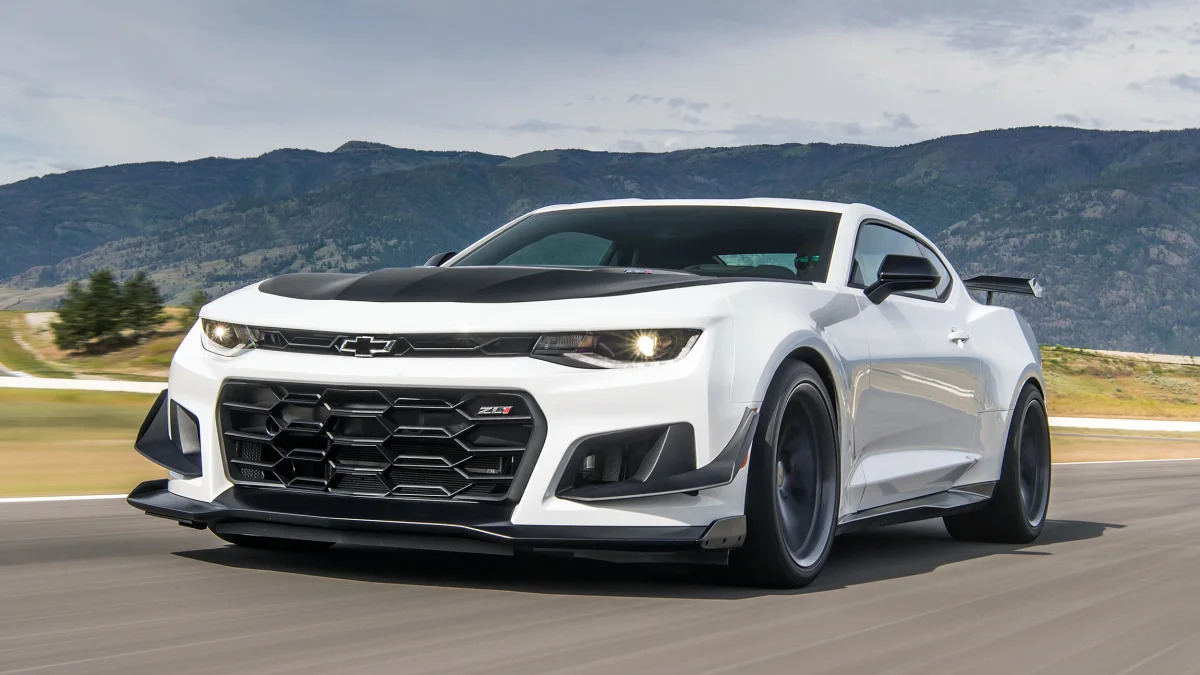









Sign in to post
Please sign in to leave a comment.
Continue